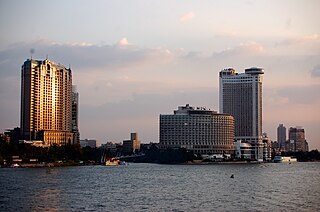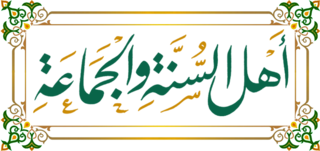
The Grand Mosque seizure occurred during November and December 1979 when insurgents calling for the overthrow of the House of Saud took over Masjid al-Haram in Mecca, Saudi Arabia. The insurgents declared that the Mahdi had arrived in the form of one of their leaders – Mohammed Abdullah al-Qahtani – and called on Muslims to obey him. For nearly two weeks Saudi Special Forces, assisted by Pakistani and French commandos, fought battles to reclaim the compound.

Diraz is the biggest and most populated village on the northwest coast of Bahrain. It lies to the east of Budaiya, west of Barbar and north of Bani Jamra. Two Dilmun era archaeological sites, namely Diraz Temple and Ain Umm Sujoor, are located in this village.

Qatar is a Muslim-majority country with Islam as the state religion. Salafi version of Islam is the state sponsored brand of Islam in the country, making Qatar one of the two Salafi states in the Muslim world, along with Saudi Arabia.
Al-Quds Mosque Hamburg was a mosque in Hamburg, Germany that preached Sunni Islam. Al-Quds is where some of the September 11 attackers including Mohamed Atta, Marwan al-Shehhi, Ramzi bin al-Shibh, and Ziad Jarrah attended and met one another, forming the Hamburg cell.

The Sheikha Salama Mosque is a mosque in the city of Al Ain, Emirate of Abu Dhabi, the United Arab Emirates. Currently the largest mosque in use in the city, its status is meant to be replaced by the under-construction Sheikh Khalifa Bin Zayed Al Nahyan Mosque. It is named after Sheikhah Salamah, mother of Sheikh Zayed bin Sultan Al Nahyan, the father of Sheikh Khalifa.

The Yemeni Crisis began with the 2011–12 revolution against President Ali Abdullah Saleh, who had led Yemen for more than three decades. After Saleh left office in early 2012 as part of a mediated agreement between the Yemeni government and opposition groups, the government led by Saleh's former vice president, Abdrabbuh Mansur Hadi, struggled to unite the fractious political landscape of the country and fend off threats both from Al-Qaeda in the Arabian Peninsula and Houthi militants that had been waging a protracted insurgency in the north for years. In 2014, Houthi fighters swept into the capital of Sana'a and forced Hadi to negotiate a "unity government" with other political factions. The rebels continued to apply pressure on the weakened government until, after his presidential palace and private residence came under attack from the militant group, Hadi resigned along with his ministers in January 2015. The following month, the Houthis declared themselves in control of the government, dissolving Parliament and installing an interim Revolutionary Committee led by Mohammed Ali al-Houthi, a cousin of Houthi leader Abdul-Malik al-Houthi. However, Hadi escaped to Aden, where he declared that he remains Yemen's legitimate president, proclaimed the country's temporary capital, and called on loyal government officials and members of the military to rally to him. On 27 March 2015, BBC reported that Hadi had "fled rebel forces in the city of Aden" and subsequently "arrived in Saudi Arabia's capital Riyadh" as "Saudi authorities began air strikes in Yemen". Civil War subsequently erupted between Hadi's government and the Houthis. Since 2017 the separatist Southern Transitional Council (STC) has also fought against the government.

Al Jum'ah Mosque, also known as Bani Salim Mosque, Al-Wadi Mosque, Al-Ghubaib Mosque, or 'Atikah Mosque, is a mosque in Medina, Saudi Arabia. It is said by the locals to be where the Islamic prophet Muhammad and his companions did a Jumu'ah prayer for the first time during their route of hijrah (migration) from Mecca to Medina.

Sidi Abu Madyan Mosque or the Worshipper's Mosque is a historic Islamic religious complex In Tlemcen, Algeria, dedicated to the influential Sufi saint Abu Madyan. Abu Madyan was hailed from Seville and contributed greatly to the spread of tasawwuf in the Maghreb region.

Ali Bitchin Mosque or Zawj Euyun Mosque is a historic mosque in Algiers, Algeria. The mosque is situated inside the UNESCO World Heritage Site Casbah of Algiers. It is located at the crosspoint between the Bab al-Wadi Street and the lower area of casbah.

Sidi Okba Mosque is the oldest surviving mosque in Algeria. The mosque was first established as the mausoleum in 686 dedicated to Uqba ibn Nafi, a sahaba and one of the prominent commanders of the early Muslim conquests of North Africa. The mosque has witnessed many renovations since then.
The 2018 Tunisian protests are a series of protests occurring throughout Tunisia. Beginning January 2018, protests erupted in multiple towns and cities across Tunisia over issues related to the cost of living and taxes. As of January 9, the demonstrations had claimed at least one life, and revived worries about the fragile political situation in Tunisia.

An-Nukhailah Mosque is an historic Shi'ite Islam mosque in the town of Al Kifl, Iraq. The mosque is a complex which contains the Dhu'l Kifl Shrine, which is believed to be the tomb of the prophet Dhul-Kifl, who is considered to be Ezekiel.

Al-Rahman al-Rahim Mosque is a mosque in Cairo, Egypt. It is located in Abbassia neighborhood, on Salah al-Salam Street toward to the city of Alexandria. The mosque is newly inaugurated in 2016 by the Ministry of Awqaf. It has an area size of 400 square meters, and attached with a library and the center of Qur'anic memorization. The construction cost reached 3 million Egyptian pounds. It features a mixture of different architectural styles, including the Mamluk, Andalucian and Fatimid.

Amir Qijmas al-Ishaqi Mosque or Abu Heriba Mosque is a historic mosque in Cairo. It is located in El-Darb El-Ahmar district, near Bab Zuweila of the Muizz Street.

Al-Mahmoudia Mosque is a historic mosque in the city of Cairo. It is located at the Salahuddin Square in the Citadel of Cairo area, in front of Bab al-Azab gate of the citadel. There are Sultan Hassan Mosque and Al-Rifa'i Mosque to the east.

Al-Fath Mosque is a mosque in the city of Cairo. Located in the Ramses Square, it is among the largest mosques and equips the tallest minaret in the city. During the post-coup unrest in Egypt, the Second Ramses Incident took place in the mosque on August 16, 2013 which resulted in the death and injury of several protesters and subsequent shut down of the mosque.

Andalusian Mosque is a mosque in Fes el Bali, the old medina quarter of the city of Fez, Morocco. The mosque dates back to the inception of the city in the 9th century, with the completion of the initial foundation in 859-860. This makes it one of the oldest mosques in the world. The mosque had been renovated and expanded several times since then. Today, it is one of the relatively few remaining Idrisid-era establishments and the main landmarks of the city.

Sheikh Khalifa Bin Zayed Al Nahyan Mosque, also known as "Al Ain Grand Mosque", "Sheikh Khalifa Bin Zayed Grand Mosque", or simply Sheikh Khalifa Mosque, is an under-construction mosque in the city of Al Ain in the Emirate of Abu Dhabi, the United Arab Emirates. Once completed, it is expected to be the largest mosque in the city, and one of the largest in the country. It is named after the current Emir of Abu Dhabi and President of the UAE, Sheikh Khalifa bin Zayed Al Nahyan.


























